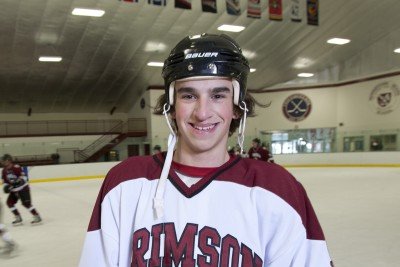CJ’s Story
Carl Joseph “CJ” Postighone’s story is best summarized with the title: Fierce Determination. The characters include a courageous and fiercely determined child. A fiercely determined, multidisciplinary, and creative medical team. And an extraordinary family, fiercely determined not only to survive an ordeal few can imagine but to emerge stronger than ever.

Pediatric oncologist Leonard H. Wexler is gentle in manner but blunt in describing Carl Joseph “CJ” Postighone’s circumstances when they first met in 2000: “He was a beautiful five-year-old boy with a very bad cancer.”
CJ was diagnosed with a rare pediatric cancer called rhabdomyosarcoma. The disease arises from cells that normally develop into skeletal muscles. It can affect almost any part of the body: the head and neck, the urinary and reproductive organs, the chest and abdomen, or, as in CJ’s case, the extremities. CJ’s rhabdomyosarcoma arose in his right buttock.
“There is a common variant called embryonal rhabdomyosarcoma,” explains Dr. Wexler, “and a less common and more virulent variant called alveolar rhabdomyosarcoma, more typically found in tumors of the extremities. That’s what CJ had.”
It began when CJ complained that his thigh was “itchy.” Within days, his parents, Carl and Robyn — an internist and nurse respectively — noted that CJ’s thigh “had more than doubled its original size and had turned a mottled color,” Mrs. Postighone recalls. An x-ray suggested a possible injury. CJ played ice hockey. At five he was already a gifted athlete.
But an injury heals. This did not. Then, several days later, came devastating news: An MRI scan showed “that in all likelihood this was a muscle tumor consistent with a rhabdomyosarcoma,” says Dr. Postighone. “We were in disbelief.”
Initial consultations with oncologists in New Jersey, where the family lives, convinced the Postighones that Memorial Sloan Kettering was the institution at which they wanted their child treated.
Treatment for rhabdomyosarcoma, then and now, consists of chemotherapy and radiation and, in selected cases, surgery. CJ was treated first with “a very intensive five-drug chemotherapy regimen not considered standard at the time,” says Dr. Wexler. It was a profoundly rigorous course. “They had to make him very, very sick to make him better,” says Dr. Postighone.
Then Michael P. La Quaglia, Chief of the Pediatric Surgical Service, and John H. Healey, Chief of the Orthopaedic Service, collaborated on surgery to remove all remaining disease.
But even before surgery, imaging studies showed that the news was good: “After the initial 12 weeks of chemotherapy, the cancer in the lymph nodes in CJ’s pelvis and abdomen to which the disease had spread had virtually disappeared,” Dr. La Quaglia says. “And the primary tumor, in his buttock, showed an approximately 90 percent reduction in volume. I removed the lymph nodes and worked with Dr. Healey to remove the residual tumor.”
But that was not the end of CJ’s time in the operating room.
To decrease the dose of external beam radiation that CJ would receive after surgery, radiation oncologist Suzanne L. Wolden collaborated with her surgical colleagues and Memorial Sloan Kettering medical physicists to deliver a dose of intraoperative radiation to CJ’s pelvis and abdomen.
“Radiotherapy works very well to help cure rhabdomyosarcoma,” says Dr. Wolden. “However, the doses needed to treat it effectively are associated with severe long-term side effects. Our challenge is to maximize effectiveness while being very creative at minimizing those side effects. This is something we’re uniquely suited to do here. Very few places in the world do intraoperative radiation for children.”
As a result of the intraoperative radiation, Dr. Wolden was indeed able to reduce the dose of external beam radiation that followed — every day for six weeks — along with six additional rounds of chemotherapy.
Asked how the family persevered, CJ’s sister, Cassandra, eight at the time of his diagnosis and now a sophomore at Villanova University, gestures at her brother: “Because of him. I remember one day our mother was crying and CJ, who was still only five, went up to her and said, ‘Mommy, you have to believe.’ ”
Carl Postighone adds, “It’s also hard to imagine how we could have gotten through this without Lenny and the entire Memorial Sloan Kettering team. They had an extraordinary ability to give us the confidence that we could get through the journey, that there was no mountain we couldn’t climb.”
“Later, after it was all over, I had these bracelets made,” CJ says. A small pile rests on the kitchen table. They are blue rubber. He sells them to raise money for the American Cancer Society. They read, simply, Believe.
Even at five years old, even through the most grueling days of treatment, CJ believed he would recover — and he remained an athlete. During numerous hospitalizations, his parents brought him his hockey stick so he could play in the hospital corridors. And when he was home and well enough, he was back on the ice — sometimes wearing a knapsack containing his chemotherapy.
Today, despite his illness and the resultant loss of muscle, he plays competitive ice hockey with his high school team, the Morristown-Beard Crimson, ranked one of the top ten high school teams in New Jersey. His position is forward. “He is lucky Number Five,” says his mother.
“I remember Dr. Wexler saying, ‘CJ’s going to be fine. I’m going to be at his high school graduation,’ ” continues Mrs. Postighone, her eyes reddening. “We’re almost there, and he will be.”
CJ graduated from high school in 2012 and played hockey in college.





